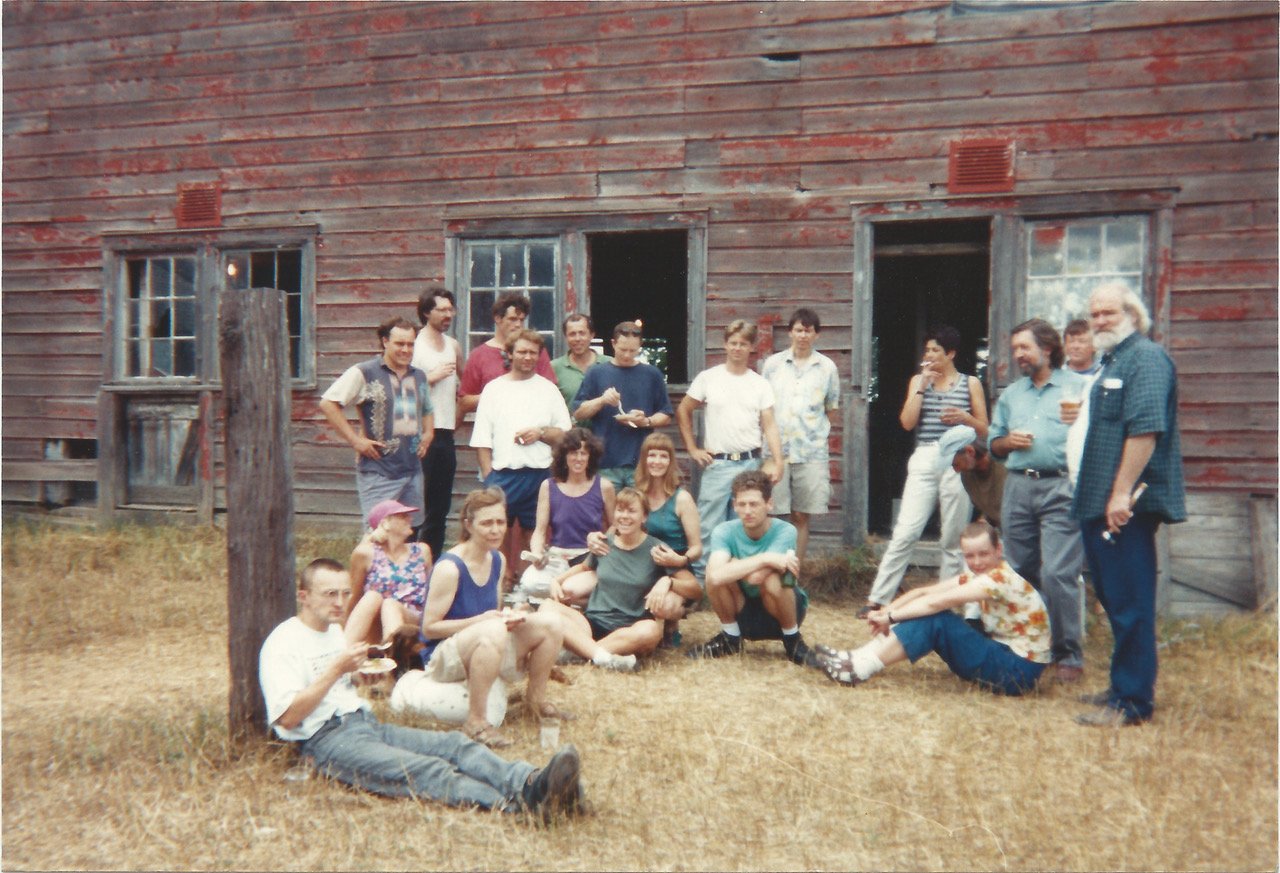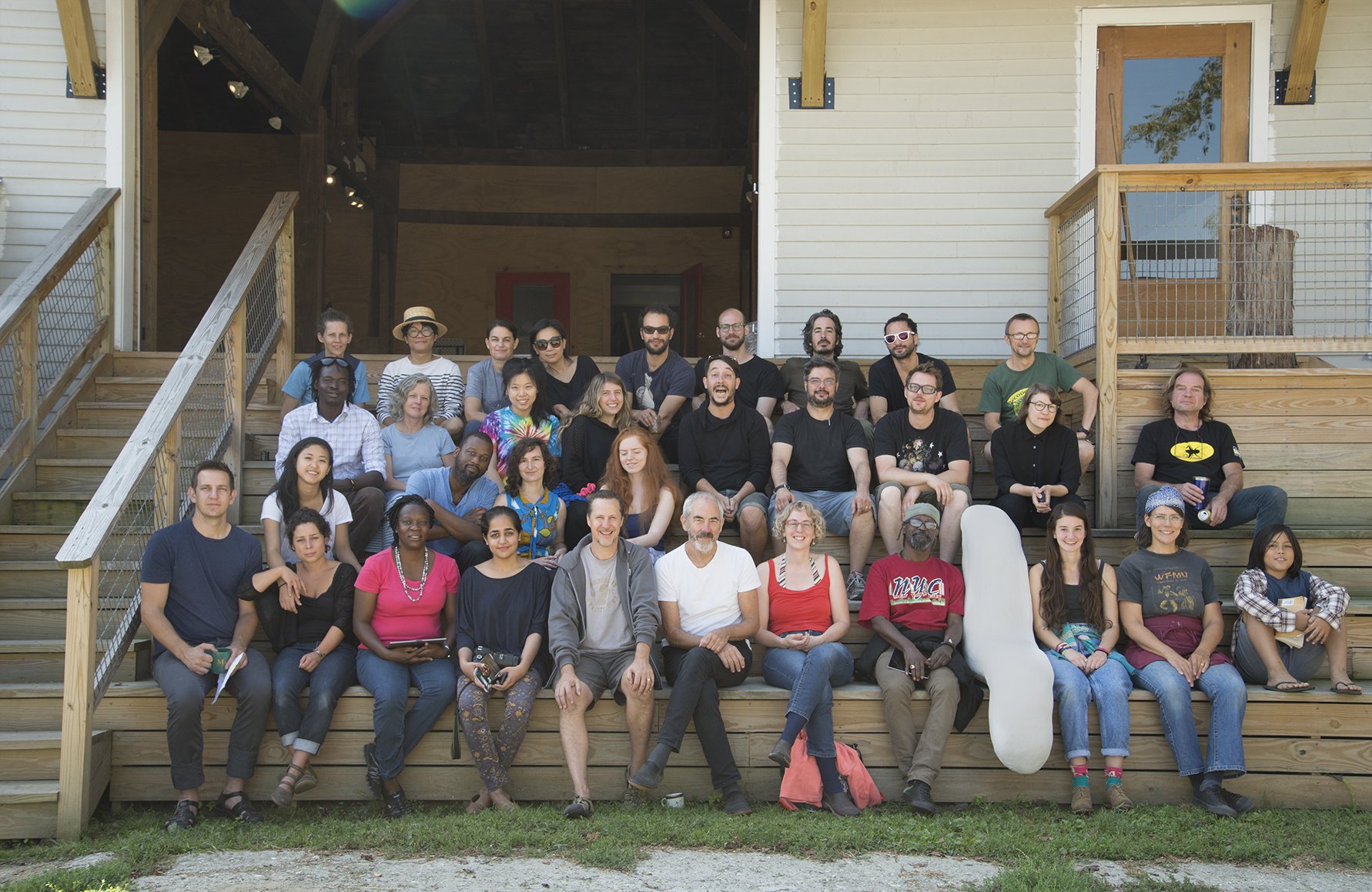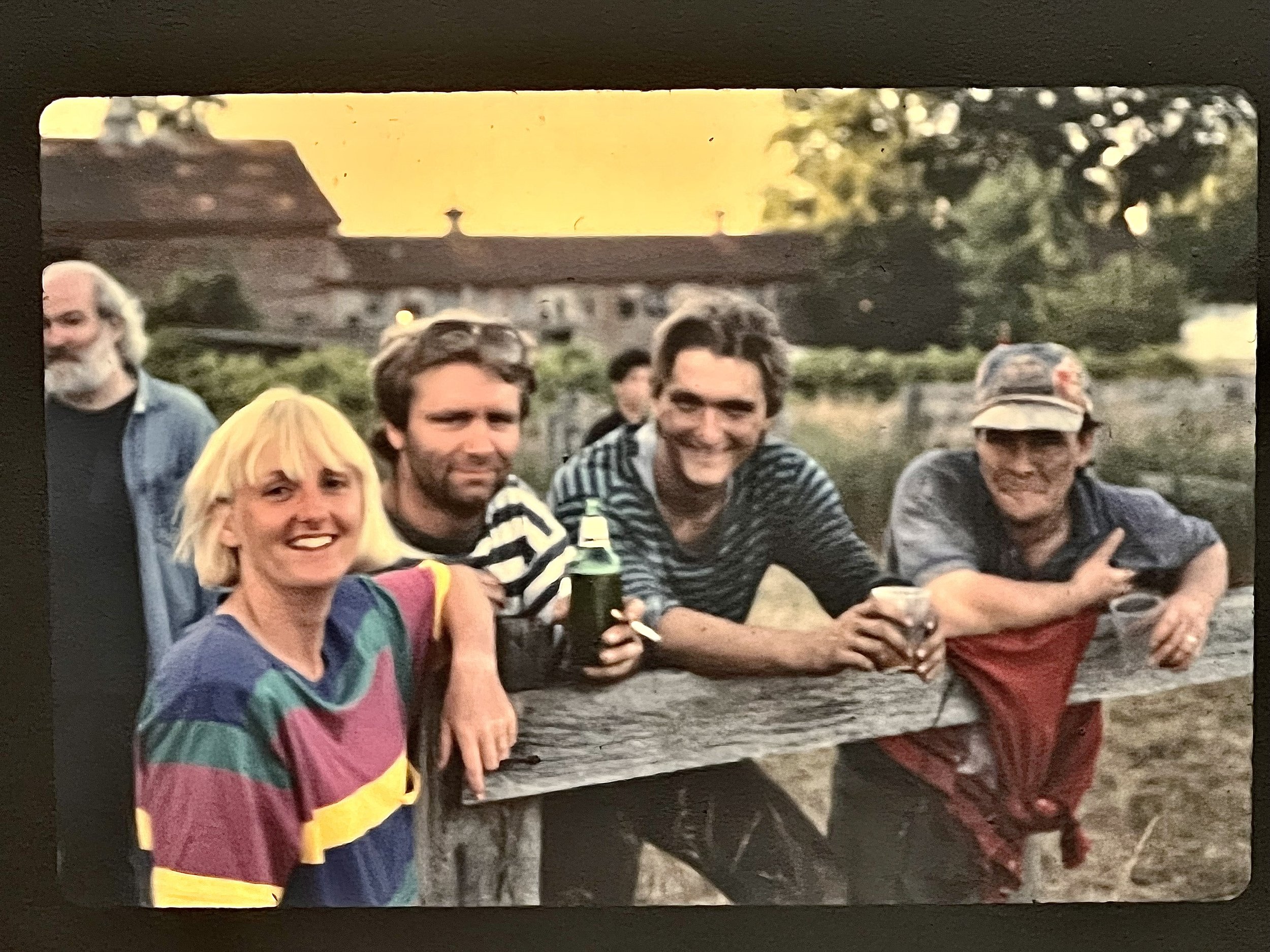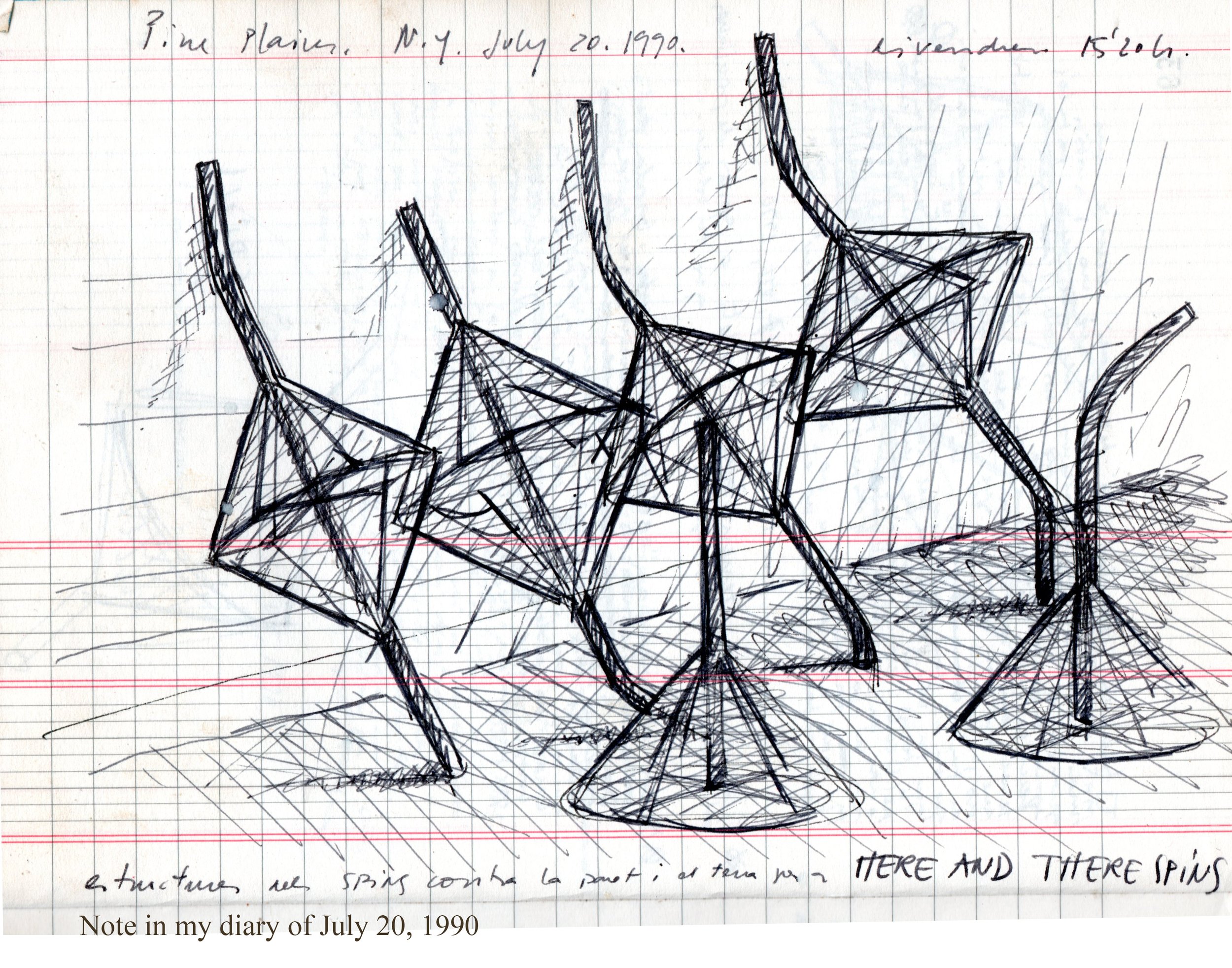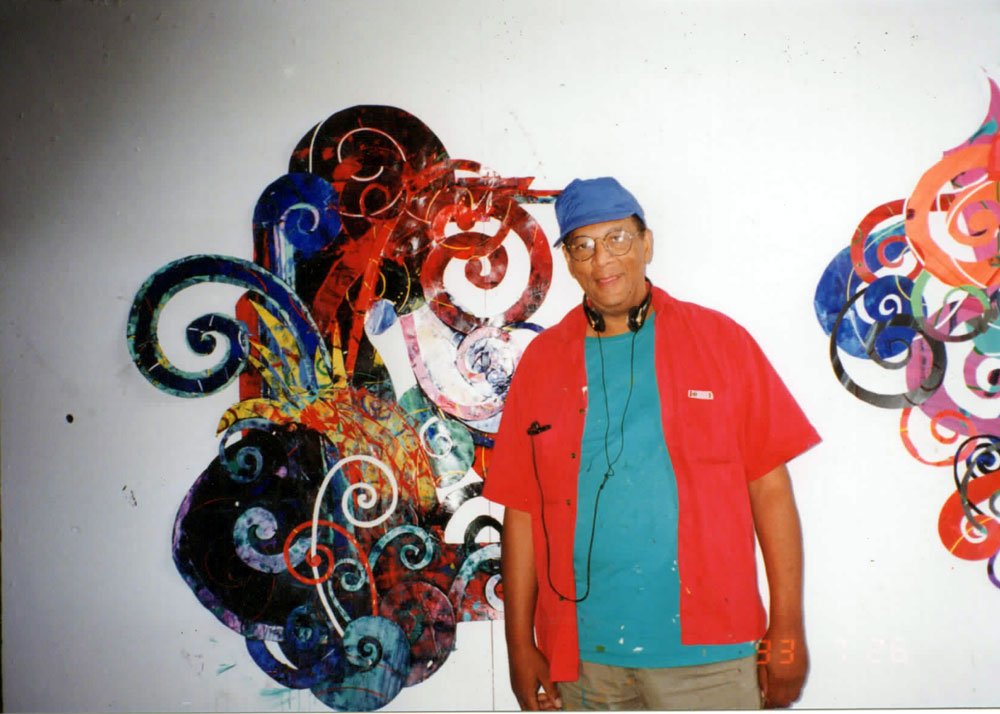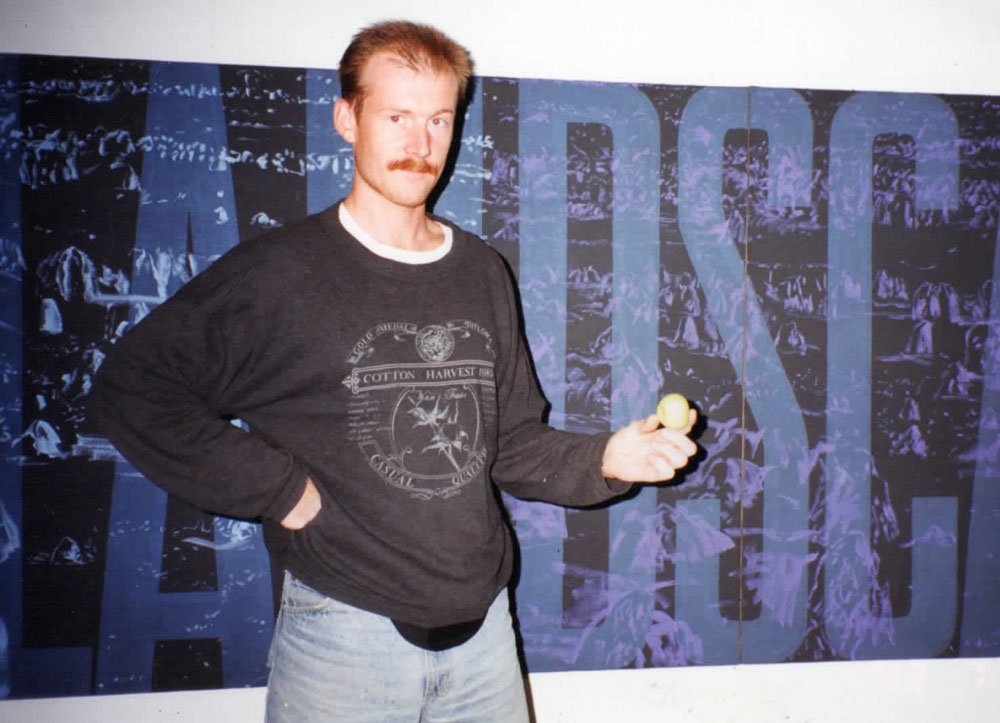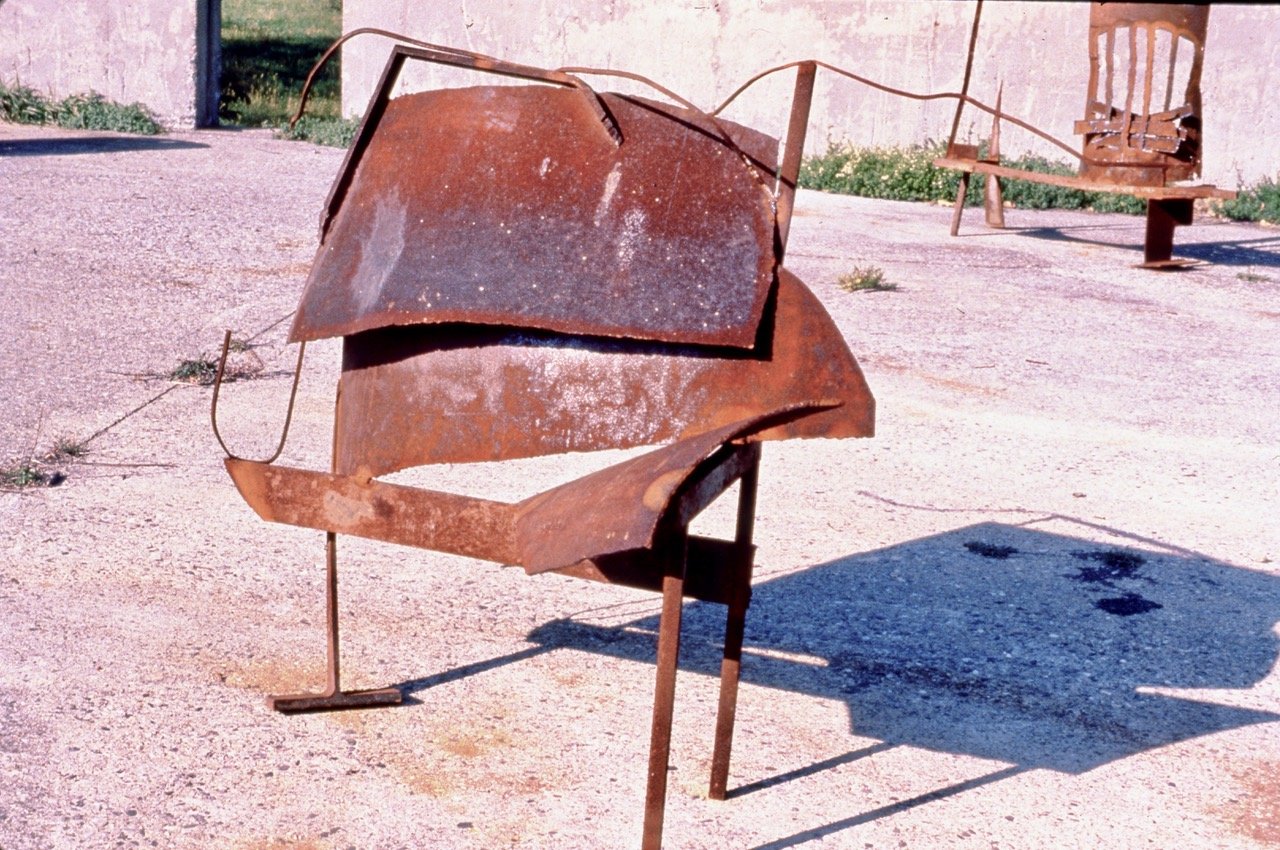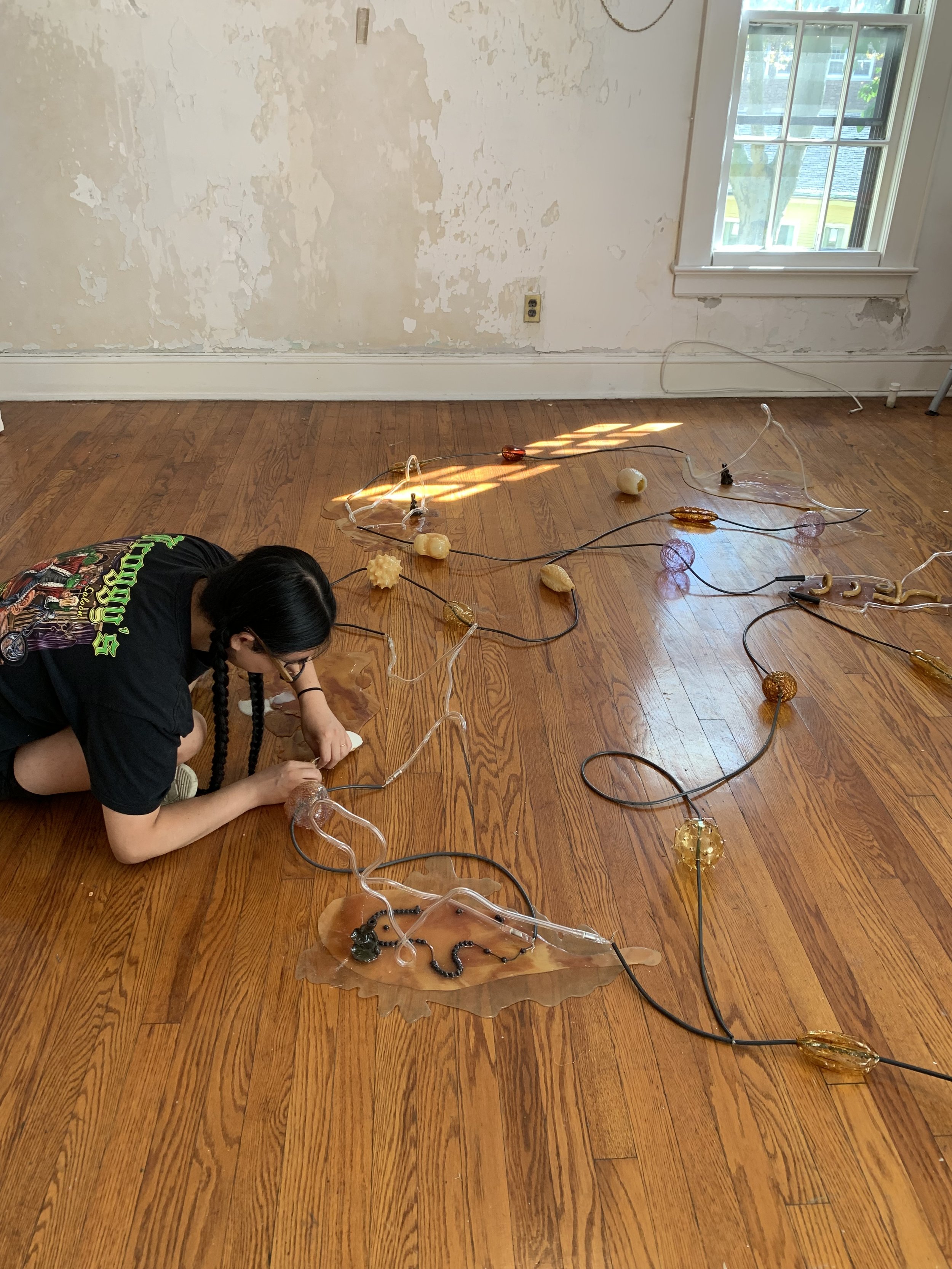History
Triangle was founded in 1982 by artist Anthony Caro and founder of Gasworks, Robert Loder. Its first program, the Triangle Artists’ Workshop, was organized in the summer of 1982, when twenty-five artists from New York City, the United Kingdom, and Canada—forming the original “triangle”—were invited to Mashomack Fish and Game Preserve in Pine Plains, New York. The workshop aimed to provide artists with space and time to enter into dialogue and exchange ideas, knowledge, and skills with each other. The focus of the workshop was on the process of making work rather than the end product.
Originally envisioned as a very loosely structured, one-off experiment, the workshop had a profound impact upon its participants and was repeated annually at Mashomack until 1993, with an additional workshop held in Barcelona, Spain in 1987. During that time, Triangle became increasingly international, as artists from all over the world applied and were selected to participate in the workshop. Invigorated and inspired by their experiences at the workshop, many of the artists returned to their home countries and started their own workshops and art spaces while maintaining contact with one another. Thus, the Triangle Network was formed.
Today this network is comprised of members in nearly 40 countries. Many of these spaces offer studios for local artists, international residencies, exhibitions, and community outreach activities. While being part of the Triangle Network offers an opportunity for support and exchange, each partner remains independent and develops programs that respond to the local needs of their artists and audiences.
Triangle Arts Association in New York has continuously facilitated workshops as part of its programs since 1982. The 1993 workshop was the last workshop to take place in Pine Plains, NY. In 1995 the workshop was held in Marseille, France, and in Monroe, NY, in 1997. The workshops have been held biennially, since 1998, when Triangle moved to the North Tower of the World Trade Center. Displaced after the tragic events of September 11, 2001, Triangle relocated to its current location in Dumbo, Brooklyn in 2002. In 2015 the workshop returned to its upstate roots, taking place in Salem, New York.
Meanwhile, Triangle’s programs in New York City have expanded over the years and also include residencies, public programs, educational initiatives, publications, and exhibitions.
40 Years of Triangle
40 Years! Longevity in the art world is always notable, but for Triangle it’s especially surprising: we began four decades ago with a one-off event, the Workshop, that was never intended to be repeated. After two summer weeks of intense art-making and shared community, it was decided that the Triangle Workshop in fact must be repeated, and that this model of process-focused, collaborative studio time should be shared worldwide. So it was, and the Triangle Network is now going strong on six continents. You can read more about our extraordinary history here. This beautiful site, compiled by Diana Sofia Lozano, is a testament to the community of artists Triangle has supported throughout that history. Much has changed since 1982. Our mission, newly articulated but long a core principle for Triangle, is to provide a life-changing working environment for committed artists. It is an ambitious one: residencies function today in a much more crowded field of proliferating opportunities, large and small. But we hold the view that residencies can be uniquely transformative for artists. The images and words that follow are a consummate testament to this.
Cara London’s Studio, Workshop 1986, Pine Plains NY
Inaugural Triangle Workshop, 1982, Pine Plains NY
“We all often collaborated and experimented with works on the floor as well as the barn walls.”
Sandi Slone (above in 1982 with Anthony Caro, Sheila Girling, and others), Workshop 1982, 1987, 1990
“I attended Triangle in 1986; it was a “before and after” moment in my life. I was 24 and was one of the youngest participants that season. I was terrified, intimidated and exhilarated all at once. As a city girl, having a gorgeous barn with a magnificent view for my studio was heavenly. It was a dream to be there with Clem Greenberg, Karen Wilkin, and Michael Fried, the guest critics. I remember evening drawing sessions when Tony Caro’s sculpture model, Concetta, posed for us. We also drew Clem Greenberg while he read the paper. I also recall that Michael Fried gave a talk on Constable’s “The Grain Sifters.” My friends acted it out; nerdy artist humor, I suppose [pictured below]. The food was just delicious. I remember an evening of guitar playing, fireworks and star gazing. Many of us are still in touch. Being at Triangle was also quite challenging, but it was one of the most important experiences of my life. It helped to set my aesthetic course as an artist.”
Cara London, Workshop 1986
Snapshots Submitted by Cara London, Workshop 1986, Pine Plains NY
“I am grateful to Triangle for all it has offered … friendships, good council, and the fond memories of those no longer with us.”
Clay Ellis, Workshops 1982, 1987, 1990, 1995, 2002
“On the second morning of the workshop, I began working on a new painting. After some time, feeling like I needed some distance, I made my way into the studio where Larry Poons was set up to work. It was just off an area in the large communal barn where I was located. Just the day before, Larry and I had chatted for an hour and when I poked my head in to say hello, he motioned for me to come in. I quietly sat down in a corner upon an overturned pail. There was no one else there, just us. I saw that all four sides of the room had been wrapped in one continuous piece of canvas stapled to the walls, covering the full height from floor to ceiling. Larry was busy mixing paint in pails of varying sizes, some very large. Larry began. He hoisted one of the full pails onto his bare shoulder and with one athletic turn of his body, he flung paint onto the canvas. The paint landed with a grand wet splat and oozed slowly down to the floor. Another pail, another colour and more hurling ensued. Stones, dirt, corn kernels, gel, whatever was at hand made it into the painting. Streams and layers of thick paint surrounded us. When it was done, the entire canvas and floor was completely covered in paint, pails strewn. Larry was drenched with paint and sweat. Though physically not a large man, there was no mistaking the grand scope of his feelings. He was fearless, daring, audacious and unconventional. As I wrote in the catalogue of that year, Triangle was definitely a turning point for me. Watching Larry work completely changed the way I approached my painting from then on.”
Judith Singer, Workshop 1983
Snapshot of Larry Poons’ studio, Workshop 1983, Pine Plains NY. Submitted by Judy Singer
Clement Greenberg in Peggy Cyphers’ studio, Workshop 1992, Pine Plains NY.
Clement Greenberg and Gregory Coates, Workshop 1992, Pine Plains NY.
Left: Workshop Participants, 1993, Pine Plains NY. Submitted by Sue Gill. Right: Workshop Participants, 1993, Pine Plains NY. Submitted by John Bjerklie
“I was surprised to see a car pull up to the Triangle Workshop with the words “Tuxedo Police” printed in 2’ tall bold letters. Anthony Cafritz was standing nearby and I said to him in amazement, “We don’t take our dress code quite that serious in Canada - was I supposed to bring formal attire?” He laughed at the kid from Northern Canada attending his first US residency. I had assisted Anthony Caro for several months while he inspired us at the University of Alberta; Tony encouraged an open-ended proposition where one could simultaneously serve their own deepest concerns AND invite the viewer into owning the metaphor for themselves! I learned that the points on the Triangle were the US, the UK and Canada. But Edmonton never hosted a residency. After years of study, effort and community building I am proud to say that a new residency called “ESP” Edmonton Sculpture Project is launched. Finally the tremendous influence of Anthony Caro and Jon Isherwood and John Hock and countless others have come to boil over in Edmonton. The influence of that formative inspiring workshop changed my life forever.”
Royden Mills, Workshop 1997
Workshop Participants, 2015, Salem NY. Submitted by Caroline Bouissou
“We had little time to meet but I think we succeeded! It was very hot, we were housed in caravans, mine was painted like a watermelon. Affinities were formed first by workshop, then extended to the whole group. I was very happy to have access to the glass workshop and be able to experiment. I recorded new sound material for sound poetry and made performances, drawings… it was prolific! I remember that this residency gave rise to some crazy pieces, like Ye-Eun's wax caravan, in which everyone ended up participating, or Thomas's crane flight. I myself stepped on dogs and encouraged people to mow their lawns according to drawings I handed out... then there was the visit of critics who didn't understand or adhere to some of the work, which raised a nice solidarity among the residents. We were lucky to have a very diverse group of culture, creation, maturity, age... I still keep in touch with many, I even collaborated with some, like John Roach and Trokon Nagbe, and we're still talking about a future collaborations with Yann Pocreau... the Triangle effect is still working !”
Caroline Bouissou, Workshop 2015
Students from The École supérieure d'art de Clermont Métropole visiting the High Line, in residence at Triangle Dumbo, 2022
Snapshots from the Triangle Workshop Catalogue, 1998-2000 World Trade Center
“I took part in a Triangle Workshop in the World Trade Centre in 2000. I remember most the sheer pleasure in just being able to get on with making work without having to deal with the ordinary machinery of life. And the people – painters working nearby, and of course Willard Boepple and Karen Wilkin. There was a genuine ferment, a sense or energy, over and above the eternal energy of New York. Some of the work I made went straight into a show back in London. I’ve still got the drawings I made looking down on Manhattan.”
Cuillin Bantock, Workshop 2000
“It was the end of the Open Day on the last day of the Triangle workshop in 2000, which of course turned out to be the last workshop in the World Trade Center. Most of the visitors had left and the artists, wanting to savor the last hours in each others’ company, were having a dance party on the dance floor of our lunch sponsor, the Windows on the World restaurant on the top of the North Tower, a mere fifteen floors above the Triangle studios!
We were all having a good time, when I noticed that the wonderful Indian artist, Manu Parekh had tears flowing down his cheeks. I rushed over to him and asked if I could help. “It’s Ok, he said - these are tears of joy! I can’t believe that not only am I in New York City, but I’m actually dancing at Windows on the World, on the 107th floor of the World Trade Center, surrounded by amazing international artists who are my new friends, and Jim Lambie is the DJ! I just can’t believe this isn't a dream!” It was a very emotional moment - I think we hugged and then certainly got back into the rhythm of what Jim was spinning. For myself, Manu Parekh, and all of the 1998 and 2000 Triangle artists, the whole experience became incredibly poignant a little over a year later, when the Twin Towers collapsed, and many staff members from the restaurant, some of whom we got to know quite well, sadly perished as they were those who arrived earliest to serve breakfast...”
Alun Williams, Workshops 1993, 1995
“There was a genuine ferment, a sense or energy, over and above the eternal energy of New York.”
Cuillin Bantock, Workshop 2000
Joeun Kim Aatchim in her studio, courtesy of the artist, Residency 2021, Dumbo Brooklyn.
Workshop 1989, Pine Plains NY. Submitted by Jo Smail
“I feel so privileged to have been to Triangle, It was like being blasted out of a cannon! And we all did amazing work. I overheard someone say: “I am quite an important artist in my country, but here I am torn to shreds—and it was wonderful!” Tony Caro said to me one evening when we were supposed to be at dinner: “This painting is more important than dinner!” That about says it all. ART matters!”
Jo Smail, Workshop 1989
Snapshots Submitted by Jo Smail, Workshop 1989, Pine Plains NY.
“On arrival in New York City, I was greeted by a huge electrical storm and had to find my way to the Lower East Side via Port Authority Bus Terminal. After staying the night with a friend, I caught a train north towards Albany along with several other Triangle-bound artists. The train stopped at a small town near Pine Plains where we were picked up and driven to Mashomack. Despite the storm the night before, we had arrived in the middle of a heatwave with East Coast temperatures reaching over 100 some days. The large barns on the reserve were repurposed as painting and sculpture studios. Food and accommodation were provided, so all I had to do was work. Critics and artists were shipped in to critique and comment, and paint workshops were provided for those that wanted them. All in all, we were treated like royalty, all except the critiques, which could sometimes prove difficult and were the source of several arguments. George Hofmann led the workshop that year with visitors including Karen Wilkin and Clement Greenberg, whose suggestion was that I cut one of my paintings in half. Triangle founder Anthony Caro also paid a visit, along with his wife Sheila Girling. A UK painter named Basil was hilarious. There was always a glint in his eye when he seemed to be clowning around with a painting only to come up with something stunning. A couple of Canadian artists were a bit more clean cut and would comment on things they thought were unhygienic. I was friendly with an Australian painter who had the workspace next to mine and we would talk about art during interludes between working. A couple of UK sculptors were very chatty and I would often visit them in the sculpture barns, along with Vincent, a sculptor from Paris who remains a friend of mine to this day. Aged 25, I was one of the youngest participants at that year's workshop, which I was told was usually for mid-career artists. The heat was intense in the semi-open barns, so we sweated and worked, and the paint dried very quickly. I worked on a variety of ideas and made several constructions as well as an interesting series of paintings. After two weeks, everyone was exhausted and in need of a rest. My last memory of Triangle was driving away in a pick-up truck with an American sculptor and a pack of beer. He offered me a ride to New Haven where I could stay the night and pick up the train to Boston, which was the next stop on my visit to the East Coast. The work I made at Triangle was exhibited in London in the autumn of 1988.”
Ian Rawlinson, Workshop 1988
Jan Nalevka in their studio, Residency 2010, Dumbo Brooklyn.
“A paperboy delivering the New York Times to my studio was how I first learned about Triangle. Michael Brenson wrote one of the first articles about Triangle, “An Upstate Farm Where Artists Grow,” July 23, 1982. Five years earlier, I was a guest artist at the Oxbow summer residency program. So, I thought that I had some idea of what the Triangle Artists Workshop might entail. To my surprise, the second Triangle Artists Workshop in 1983 had two relatively distinct artist groups: The Painters and The Sculptors. I was neither. Being an installation-performance artist, my intent in participating at Triangle was to create the final large background flat for a video performances series entitled True Romance. Back in the 80s flats made-for-video production sets fell somewhere between illustration and painting. Clement Greenberg looked at the True Romance flat and commented, “You can tell that this guy knows how to paint,” followed up with the zinger, “This is a bad painting which is fashionable now.” A year later, David Parsons and members of the Paul Taylor Dance Company performed with the True Romance flats. I was elated.”
Ben Sarao, Workshop 1983
The New York Times, July 23 1982. Primary Image Collection. Submitted by Ben Sarao
“I remember my stay at Triangle … as an injection of creative energy and enthusiasm.”
Salvador Juanpere, Workshop 1990
Residents Eric Ramos Guerrero, Joeun Kim Aatchim, Jessica Segal, Yu Ji, and Leo Li Chen, and Residency Manager Diana Sofia Lozano, at the Easton Foundation: Louise Bourgeois House and Studio, Dumbo Residency 2021
Snapshots Submitted by John Bjerklie, Workshop 1993, Pine Plains NY.
“The 1986 Workshop was very intense. All the sculptors were welding steel, so there was no equipment for me to weld bronze. Anthony Caro came into the Welding Barn to cruise the lay of the land, bent down to see what was on the floor in front of me, turned to the boys and said with ironic disgust, “Heavens, Marsha, you’re the spanner in the works”. Much to my surprise the gossip next day was that Tony was lending me the TIG [welder] at his studio. What an unexpected and generous gesture! While Rodger Mack and I were installing the 220 for the TIG in the smaller barn, a violent thunderstorm burst from the heavens. These torrential downpours happened a lot and within a few minutes everything flooded. We had laid bare the circuit breaker when the storm broke. Just as we ran over to close the barn doors, the lightning hit the breaker and a lightning bolt struck across the room illuminating the entire space. We finally looked at each other and said in unison ‘Holy shit, we should be dead.’ A decade later I made that self-same bolt in neon. I will never forget it.”
Myrna Balk, Workshop 1983
Salvador Juanpere in his studio, Workshop 1990, Pine Plains NY.
“I was at Triangle in July 1990. I left my family, my wife and my two little daughters, Paula, seven years old, and Diana, who had just been born in March, in Barcelona. I came with almost non-existent English (it hasn't improved much) a fact that prevented me from deepening contact with the attendees. I have in my memory some impressive images: the power and immensity of the landscape and some anecdotes with some people. I became friends with the sculptor Dan Devine, we established a fun complicity, we played to imitate the manual gestures that the rest of the sculptors made to hide part of the sculptures that were in process from view. He helped me a lot in the attempt to find specific materials in the Hardware Store for the realization of my work. In his Jeep, we traveled the surrounding roads of the Mashomack Preserve; I had never seen so many wild rabbits. I remember the cordial kindness of Anthony Caro, the delicate attention he paid to our works in progress and the invitation he extended to us in his studio with his wife Sheila. I have some unforgettable flashes like when that sculptor from Zimbabwe, Adam Madebe, asked me bluntly: "Salvador, do you believe in God?", a very difficult question to answer even if I had mastered English...or those invitations from the excellent painter Erik Saxon after work: “A short walk, Salvador?" or that other invitation from the sculptor Rodger Mack to contemplate in his car those impressive expanses of wild ducks and at night, the flight of millions of Fireflies that produced a sensation unreal, like a hallucinated dream. I remember, one morning, the visit of the artist Frank Stella, who somehow reminded me of Groucho Marx, with his restless walk and nervous talk. He advised me: "Young man, do not finish this work, leave it like this in process, it will be more interesting..." I hesitated at some point, but I ignored him and finished it as I had planned. I did not yet know that those turned shapes, called "Here and There Spins,” were the antecedent of a work that I would make for a public space, near Barcelona, in Reus, two years later. I remember long work sessions, peaceful meals under of some hundred-year-old oaks and passionate discussions about art, sculpture or culture that I could hardly participate in because of my poor English.I remember, at the Workshop finale party, the familiar music of Credence Clearwater Revival in its natural, specific context , original. I remember my stay in the Triangle in 1990 as an injection of creative energy and enthusiasm.”
Salvador Juanpere, Workshop 1990
Works in progress and sketches by Salvador Juanpere, Workshop 1990, Pine Plains NY.
Left: Jean-François Coadou reuniting with Anthony Caro, Workshop 1995, Marseille, France. Right: Annabel Nowlan, Workshop 1989, Pine Plains NY.
Work by Helen Brough, Triangle Dumbo Residency Open Studios 2004. Photographs by Etienne Frossard.
“I was a resident in 2004 for 6 months at 70 Washington Street in Dumbo, Brooklyn, and at the Workshop of 2004 that was at 55 Water Street. The hanging sculpture was the start of my experiments with Plexiglas as color in space. The studio was such an inspiration. This was the sculpture that Jane and David Walentas saw and subsequently commissioned as ‘Emulated Flora’ for the present atrium at 70 Washington Street.”
Helen Brough, Residency 2003
“I still keep in touch with many…the Triangle effect is still working!”
Caroline Bouissou, Workshop 2015
“I’ve been most fortunate to have received this opportunity and I’m honored to write this as one of the first Triangle Arts Alumni Fellows. [The artist residency on Governors Island has provided] meaningful relationships and substantial growth in my art practice and the development of new work. It could not have happened at a better time.”
Jodie Lyn-Kee-Chow, Dumbo Residency 2020-2021, Governors Island Residency 2021-2022
Jodie Lyn-Kee-Chow by her installation, “A Case for Mary Williamson”, Residency 2022. Governors Island NY. Photo by Yoshi Sugito
Snapshots Submitted by Jodie Lyn-Kee-Chow, Dumbo Residency 2020, Governors Island Residency 2021-2022
“I remember being fascinated with watching John Gibbons work on his sculpture - he would stand back about two feet from the sculpture and stare at it for what seemed like hours - then he would dive in and furiously work like hell on it. He would stop and stare for hours again and then dive in again - but he did create great sculpture! My most vivid memory of the workshop was Clay Ellis and me working and welding in the extreme heat with our shirts off! It was just unbearably hot for welding and grinding. I believe I sweated off about 12 lbs.”
Ken Macklin, Triangle Workshop 1982, 1986, 1987
Francine Tint and Anthony Caro, Workshop 1986, Pine Plains NY.
“I was at Triangle in 1986. I had the chance to meet and share amazing times with great friends, both artists, and critics like Clement Greenberg, and Michael Fried. With Clement Greenberg and Anthony Caro, mostly just the three of us, I used to having fun drawing from figures at night, when everybody was partying. Once at Triangle, I had paintings outside the space, as well as inside. It started raining and everybody was scared that my painting could have been ruined. Larry Poons said I shouldn't have been scared at all because I knew and I felt myself that God, through the rain, was giving my paintings new birth.”
Francine Tint, Triangle Workshop 1986
Barn Studios, Submitted by Susan Gill, Triangle Workshop 1993, Pine Plains NY.
View of the barns by Janie Paul, Workshop 1991, Pine Plains NY.
“I was terrified, intimidated and exhilarated all at once. As a city girl, having a gorgeous barn with a magnificent view for my studio was heavenly.”
Cara London, Workshop 1986
Snapshots Submitted by Susan Gill, Workshop 1993, Pine Plains NY.
“At the Triangle workshop I made these 6 sculptures with so much enthusiasm that for me it was like a dream that hasn't left me since.”
Pierre Tual, wORKSHOP 1983
Left: Clément Greenberg, Pierre Tual, Karen Wilkin, and Anthony Caro. Right: View of the barn studios, sculptures by Pierre Tual, Workshop 1983, Pine Plains NY.
“In 1988 I was one of the artists at the Mashomack Farm in Pine Plains, NY. It was an intense time for me. I had arrived as a painter. However, on the first day Rodger Mack taught me how to cut metal with fire. On the second day he taught me how to weld pieces together. I was so charged up with my new knowledge of working with metal that I just started creating sculptures with whatever metal I could find. I made many steel sculptures in that two-week period and left the Workshop exhausted and happy.”
Anne Seelbach, Workshop 1988, Pine Plains NY.
Work by Anne Seelbach, Workshop 1988, Pine Plains NY.
Wu Chien Hsing installing an artwork, Residency 2022, Dumbo Brooklyn.
“I directed Triangle 1988, which took place at Mashomack, in Pine Plains, NY. There was a tremendous amount of work to be done to ready the barns, and housing, for the participants, who came from England, France, Canada, the US, and for the first time, mainland China, but we got it done and welcomed all. It was a notable session that year, because it may have been one of the the last in which both Clement Greenberg and Anthony Caro participated, with Tony modeling a memorable bust of Greenberg in clay. Many of the artists there that year have gone on to notable careers in art and academe: Jon Isherwood, Basil Beatty among others, and their continued success is a testament not only to their native talents, but to the contributions organizations and workshops like Triangle have made to the life of art over many years.”
George Hofmann, Workshop Director 1988, Pine Plains NY.
“The 1988 session was charged with energy. I will never forget the boost it gave to my work. I cherish the time spent with such gifted artists and remain friends with many.”
Linda Cross, Workshop 1988, Pine Plains NY.
Snapshots Submitted by Pat Service, Workshop 1983, 1993, Pine Plains NY
Ariel Kleinberg in her studio on Governors Island, 2022
“We moved as a group, listening as Larry Poons gave each artist an individual critique. I remember him carrying a stick which he occasionally pounded for emphasis, like a forbidding dancing master. I credit him with one of the two profoundly formative criticisms of my life. After looking at my paintings, he pronounced “looks like designer color”. I had been preplanning the color, but after this, I starting picking color on the fly, and intuitively. This was a much more natural and successful method for me and changed my approach profoundly. For this, I am eternally and profoundly grateful. The other critique was from the late Darby Bannard, who gently explained, “You have to get bossier with your paintings”. Another profound revelation - in total, 12 words that changed everything for me: “If you rob the f***ing bank, take the F****ING MONEY!!!!” Meaning, be the servant to whatever you mine, not the master. Another pithy but memorable Larry Poons critique during that same afternoon.”
Sheila Luck, Workshop 1989, Pine Plains NY.
Larry Poons and Clay Ellis, artwork by Clay Ellis, Workshop 1982, Pine Plains NY.
“I overheard someone say: I am quite an important artist in my country but here I am torn to shreds—and it was wonderful!”
Jo Smail, Workshop 1989
Sean Cassidy and Clay Ellis, Workshop 1990, Pine Plains NY.
“As with many of the early participants, my history with Triangle (much like that of Triangle) was rooted in the Emma Lake workshops. In 1981 the Emma workshop I attended was led by Darby Bannard and John McLean. Both great painters, and both sadly missed. John suggested, given my particular interest in sculpture, I should visit England - for good reason, as Peter Hide, John Foster, and John Gibbons were there, just to mention a few, and of course Tony Caro. It was a visit that changed everything. I was invited to the inaugural 1982 Triangle Workshop and since have participated in five others, as well as five spinoff workshops inspired by Triangle. Each completely unique, each presenting distinct challenges, each offering fringe activities (from an intimate view of Gaudi, to the salt pans of the Kalahari, to grilling sardines on the tower overlooking the old harbor in Marseille). All providing contact with a focused group of individuals, and moments of seeing art produced at the highest level. I am grateful to Triangle for all it has offered, I am truly grateful for friendships, good council, and the fond memories of those no longer with us.”
Clay Ellis, Workshops 1982, 1987, 1990, 1995, 2002
Malado Francine on Governors Island, image by Jodie Lyn-Kee-Chow, Residency 2022, Governors Island NY.
Roland Cognet and John Bjerklie, Workshop 1993, Pine Plains NY.
“I’m attaching an image of two participants from the Triangle Workshop in 1993, the year I participated too and met these two great artists: Roland Cognet from France and John Bjerklie from Brooklyn. In true Triangle style, ever since the workshop that year, (29 years ago), Roland and John have been important artistic partners and collaborators with me as well as being great friends. Their commitment to Triangle is shown for example in the fact that John is currently a long-serving and very active Board member, and Roland was the instigator of the annual Triangle residency in New York for young artists linked to the art school in Clermont-Ferrand, where he is currently Professor of Volume.”
Alun Williams, Workshops 1993, 1995
Snapshots submitted by Reem Hassan, Workshop 2004, Dumbo Brooklyn.
Painting studios, Workshop 1983, Pine Plains NY. Image Credit: Pat Service
Toilet Toiler by Andy Yoder, Workshop 2000, World Trade Center NY. Photo by Etienne Frossard
“Back around 2000 I contributed a small work to a benefit organized at Parker’s Box (Alun Williams’ gallery in Williamsburg) to help fight the coal fired power plants Giuliani wanted to build. The person accepting the work suggested I drop off slides (remember, it’s 20 years ago) after which Alun suggested I apply to Triangle. This turned out to be a phenomenal, career changing experience. I was in the midst of parenting 2 very young boys, so the workshop provided a much-needed opportunity to refocus on my work. Each day I showed up first thing in the morning and worked until late at night, struggling until I came up with a completely new project. At the end, during the open studio, a gallery invited me to show with them, and now I tell this story to my students as an example of the power of volunteering!”
Andy Yoder, Workshop 2002
Resident Stephanie Acosta in their studio with visiting critic Barbara Calderón, Residency 2022, Dumbo Brooklyn
Snapshots from workshops through the years, Pine Plains, World Trade Center and Dumbo. Submitted by John Bjerklie.
Peter Lewis, David Rhodes, Jon Isherwood, and Ian Rawlinson, Workshop 1988, Pine Plains NY.
“Significant certainly was when Michael Fried made a special point to find me in the barn studio to say, ‘Greenberg taught me to look for unity but you've proved to me that duality in painting is valid.’ ”
Marjorie Welish, wORKSHOP 1990
Workshop participants with Helen Frankenthaler. Workshop 1982, Pine Plains NY
“Here is a photo from 1982, with Helen Frankenthaler arriving at the top Painting Barn. She is beginning to crop the large work, which already has tapes on it. Being held up by Bob Scott[Canada] and my back view. It was hot!”
Patrick Jones, Workshop 1982, 1985
Left: Judy Singer and Helen Frankenthaler, Workshop 1983, Pine Plains NY. Right: Artist Helen Frankenthaler, curator and critic Karen Wilkin, and artist Rona Conti. Workshop 1983, Pine Plains NY.
“I was an artist at the Triangle workshop in DUMBO in 2010, visiting New York from Dresden/Germany for just over a month. During the two weeks of the workshop I worked mainly with found objects. I stayed with my friend, the photographer Sam Rohn in Brooklyn. He photographed me on the chimney on his rooftop, helping me add to my ever-growing collection of me on rooftops. This photo, among others, was shown during the DUMBO Brooklyn Art Festival in a former office floor.”
Elizabeth Rosenthal, Dumbo Residency 2010
Inaugural Triangle Workshop, 1982, Pine Plains, NY.
“This picture is of myself (in white at the front); it was used as the frontispiece in the first Triangle catalogue 1982, for the inaugural Triangle get together. I remember the event and that picture with great fondness. In fact a week ago I was giving a talk about William Turner the great English 19th century painter at the Turner museum in London, and mentioned Triangle 1982 as a number of the painters there including Helen Frankenthaler were enthusiastic about his late work when I mentioned him to them!”
Barry Martin, Workshop 1982
Left: Robert Loder, Alun Williams, Anthony Caro and Kyotaro Hakamata, Workshop 1995, Marseille France. Right: Larry Poons’ Shoes, Submitted by Rona Conti, Workshop 1983, Pine Plains NY
“String, Landing, Seeing Stitches” by Mo Kong, Residency 2019, Governors Island NY
“I was one of the artists in residence at Triangle in DUMBO in 2018, working on my exhibition at the Queens Museum. Later in 2019, I was at the Triangle Governors Island residency where I finished my project String, Landing, Seeing Stitches. I also curated a show including my own work as well as artists Wangui Maina and Goldie Pablador, called ‘Snails In The Rain.’”
Mo Kong, Residency 2018, 2019
“…the workshop provided a much-needed opportunity to refocus on my work. Each day I showed up first thing in the morning and worked until late at night, struggling until I came up with a completely new project…”
Andy Yoder, workshop 2002
“I was invited by Tony Caro to be a group leader, meaning Tony wanted me to go around and say something about both the painters’ and sculptors’ work. I also got paid which I think was a first. This sounds weird or strange but I created a lot of controversy because I was painting the steel sculpture polychrome, and interestingly [the controversy came] more from the painters than sculptors. The little secret in those days was that on the last weekend of the session Clem Greenberg would walk around and look at everyone's work. I had known Clem for years by that time and also knew that he wouldn't go for the painted sculpture, so I tried to duck out with Charles Millard of the Guggenheim, but that night Clem caught up with me at the clubhouse and said, "Where were you? " I said, "I went to lunch with Charlie," he said," Oh, I'll stay another day and meet you down at the sculptors’ barn." Of course, everyone was all ears, and at 9 am Clem showed up with pretty much everyone who attended that summer, and we were all in a circle around a piece I had made, and Clem said, "It’s Shit," and I said "No it's not," and walked away. There's more but....”
Peter Reginato, Workshop 1984
Peter Reginato and sculpture. Workshop 1984, Pine Plains, NY.
Participants of The Inaugural Triangle Workshop, Pine Plains, NY. Summer 1982. Photo by Clement Greenberg. Submitted by Catherine Burgess.









